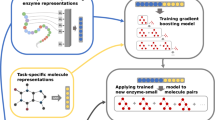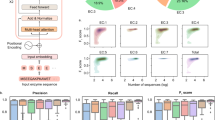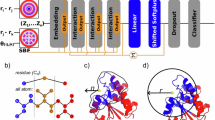Abstract
Enzymes are the molecular machines of life, and a key property that governs their function is substrate specificity—the ability of an enzyme to recognize and selectively act on particular substrates. This specificity originates from the three-dimensional (3D) structure of the enzyme active site and complicated transition state of the reaction1,2. Many enzymes can promiscuously catalyze reactions or act on substrates beyond those for which they were originally evolved1,3-5. However, millions of known enzymes still lack reliable substrate specificity information, impeding their practical applications and comprehensive understanding of the biocatalytic diversity in nature. Herein, we developed a cross-attention-empowered SE(3)-equivariant graph neural network architecture named EZSpecificity for predicting enzyme substrate specificity, which was trained on a comprehensive tailor-made database of enzyme-substrate interactions at sequence and structural levels. EZSpecificity outperformed the existing machine learning models for enzyme substrate specificity prediction, as demonstrated by both an unknown substrate and enzyme database and seven proof-of-concept protein families. Experimental validation with eight halogenases and 78 substrates revealed that EZSpecificity achieved a 91.7% accuracy in identifying the single potential reactive substrate, significantly higher than that of the state-of-the-art model ESP (58.3%). EZSpecificity represents a general machine learning model for accurate prediction of substrate specificity for enzymes related to fundamental and applied research in biology and medicine.
This is a preview of subscription content, access via your institution
Access options
Access Nature and 54 other Nature Portfolio journals
Get Nature+, our best-value online-access subscription
$32.99 / 30 days
cancel any time
Subscribe to this journal
Receive 51 print issues and online access
$199.00 per year
only $3.90 per issue
Rent or buy this article
Prices vary by article type
from$1.95
to$39.95
Prices may be subject to local taxes which are calculated during checkout
Similar content being viewed by others
Author information
Authors and Affiliations
Corresponding authors
Supplementary information
Supplementary Information
Supplementary Text sections 1–7, Supplementary Figs 1–52, Supplementary Tables 1–13 and references.
Rights and permissions
About this article
Cite this article
Cui, H., Su, Y., Dean, T.J. et al. Enzyme specificity prediction using cross attention graph neural networks. Nature (2025). https://doi.org/10.1038/s41586-025-09697-2
Received:
Accepted:
Published:
DOI: https://doi.org/10.1038/s41586-025-09697-2



